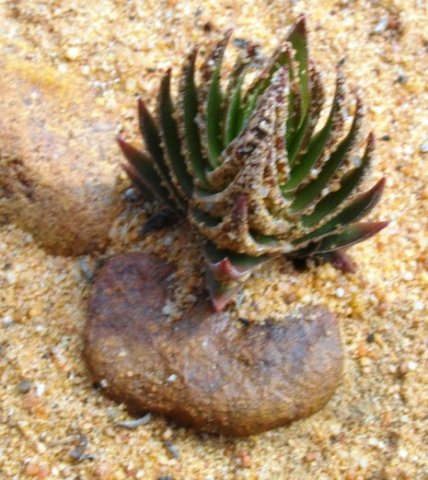Crassula alpestris subsp. alpestris in its sandy cloak

Author: Ivan Lätti
Photographer: Ivan Lätti
The crowded leaves of this young Crassula alpestris subsp. alpestris plant, curving up in four neat, vertical arrays, are strangely covered in sand.
This is a characteristic survival feature of the species that has to withstand challenging temperature extremes in its demanding habitat. The close, even spacing of the leaves near the ground, where the light-coloured sand reflects the sunlight, serves the same purpose. The leaves remind of blades on some car radiators.
The self-inflicted sand coating functions like one of the world’s oldest, externally applied sunblocks, resembling mammals rolling in mud to cool off. It serves a similar purpose to a hairy indumentum on leaf or stem and is unusual but not unheard-of in plant world.
The chances of being eaten by a browser are reduced when the sandy covering on the outside serves effectively as camouflage. The brainier browser might also look elsewhere when the thought of a mouthful of sand dawns in time.
Some of the photos of this Crassula were taken during September at Kagga Kamma in the Ceres Karoo, Cederberg country. Note how other plants lacking sandy coverings are very red, a sign of stress due to nakedness in the face of the elements or exhaustion from flower production.
Adam Harrower (2012) who has written an excellent article about C. alpestris for www.plantzafrica.com suggested the name of sand-coated crassula for the plant (Manning and Goldblatt, 1997; Bond and Goldblatt, 1984; www.plantzafrica.com; www.ispot.org.za).

